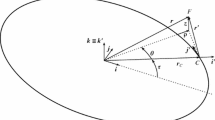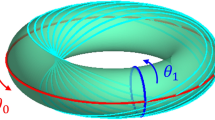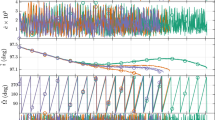Abstract
The error propagation characteristics of different points of a halo orbit are studied in this paper. The condition number of state transition matrix after a period is used to estimate the sensitivity of different positions on a halo orbit to the state errors. Then the covariance propagation method is applied to compute the error covariance matrix under the initial state errors, and the results are validated by Monte Carlo simulation. The variations of the position error are compared with the variations of the condition number. The results show that the variation trend of the position error after a period of that halo orbit is the same as the variation trend of the condition number. Moreover, this identified property is verified by testing the halo orbits with different amplitudes and the halo orbits in systems with different mass ratios. Finally, the variation trends of the condition numbers against propagation time corresponding to different points on the halo orbit are analyzed. It is shown that the largest point in the negative \(z\) direction of the north halo orbit and its vicinity are more sensitive to state errors than other positions on the halo orbit, and they should not be selected as the injection point.









Similar content being viewed by others
References
Breakwell, J.V., Brown, J.V.: Celest. Mech. 20(4), 389 (1979)
Farquhar, R.W.: Station-keeping in the vicinity of collinear libration points with an application to a lunar communications problem. In: AAS Space Flight Mechanics Specialist Conference, Colorado, p. 519 (1966)
Farquhar, R.W., Dunham, D.W., Guo, Y., McAdams, J.V.: Acta Astronaut. 55, 687 (2004)
Folta, D.C., Pavlak, T.A., Haapala, A.F., Howell, K.C., Woodard, M.A.: Acta Astronaut. 94, 421 (2014)
Geller, D.K.: J. Guid. Control Dyn. 29(6), 1404 (2006)
Ghorbani, M., Assadian, N.: Adv. Space Res. 52, 2067 (2013)
Gómez, G., Howell, K.C., Masdemont, J., Sin, C.: Adv. Astronaut. Sci. 99(2), 949 (1998)
Gómez, G., Masdemont, J., Mondelo, J.M.: Libration point orbits and applications. In: Proceedings of the Conference Aiguablava, Spain, p. 10 (2002)
Grebow, D.J.: Generating Periodic Orbits in the Circular Restricted Three-Body Problem with Applications to Lunar South Pole Coverage. Dissertation, Purdue University (2006)
Gurfil, P., Meltzer, D.: J. Astronaut. Sci. 54(1), 29 (2006)
Howell, K.C.: Celest. Mech. 32(1), 53 (1984)
Howell, K.C., Breakwell, J.V.: Celest. Mech. 32(1), 29 (1984)
Howell, K.C., Pernicka, H.J.: J. Guid. Control Dyn. 16(1), 151 (1993)
Koon, W.S., Lo, M.W., Marsden, J.E.: Celest. Mech. Dyn. Astron. 81(1), 63 (2001)
Li, M.: Zheng, J Chin. J. Space Sci. 30(6), 540 (2010)
Maybeck, P.S.: Stochastic Models, Estimation and Control. Academic Press, New York (1982)
Moore, A., Sina, O.B., Marsden, J.E.: J. Guid. Control Dyn. 35(5), 1507 (2012)
Richardson, D.L.: Celest. Mech. 22(3), 241 (1980)
Serban, R., Koon, W.S., Lo, M.W., Marsden, J.E., Petzold, L.R., Ross, S.D., Wilson, R.S.: Automatica 38, 571 (2002)
Simó, C., Gómez, G., Llibre, J., Martinez, R., Rodriguez, J.: Acta Astronaut. 15(6/7), 391 (1987)
Tang, G., Jiang, F.: Astrophys. Space Sci. 361, 10 (2016)
Wu, L., Liu, Z., Tang, C.: Sci. China Inf. Sci. 55, 1249 (2012)
Zhang, S.Y.: Theory of Periodic and Quasi-Periodic Orbits Surrounding the Collinear Libration Points. Dissertation, PLA Information Engineering University (2009)
Acknowledgements
The authors would like to acknowledge the support from the National Natural Science Foundation of China (Grants No. 11402295) and the Science Project of the National University of Defense Technology (No. JC14-01-05). The authors acknowledge the support of Xiyun Hou for helping prove that the eigenvalues of the monodromy matrices of different positions are the same.
Author information
Authors and Affiliations
Corresponding author
Rights and permissions
About this article
Cite this article
Sun, Y., Zhang, J. Error propagation characteristic analysis of halo orbit based on condition number of state transition matrix. Astrophys Space Sci 361, 297 (2016). https://doi.org/10.1007/s10509-016-2856-3
Received:
Accepted:
Published:
DOI: https://doi.org/10.1007/s10509-016-2856-3




